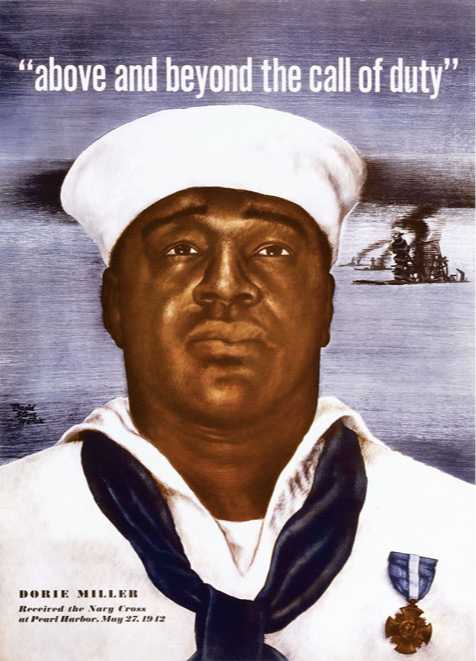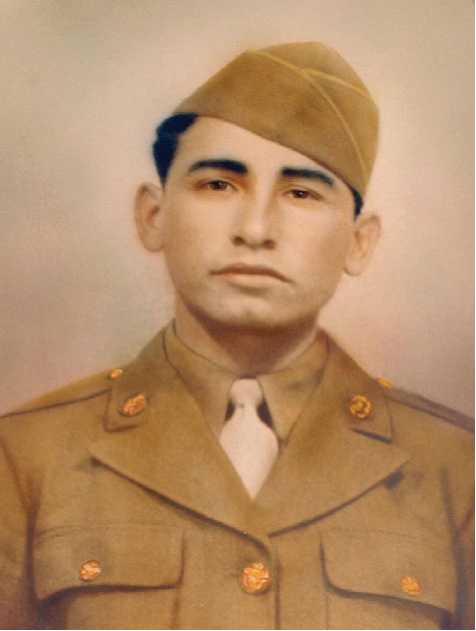The war affected black Americans in many ways. Several factors helped improve their lives. One was their own growing tendency to demand fair treatment. Another was the reaction of Americans to Hitler’s barbaric treatment of millions of Jews, an outgrowth of his doctrine of “Aryan” superiority. These barbarities compelled millions of white citizens to reexamine their views about race. If the nation expected African Americans to risk their lives for the common good, how could it continue to treat them as second-class citizens? Black leaders pointed out the inconsistency between fighting for democracy abroad and ignoring it at home. “We want democracy in Alabama,” the NAACP announced, and this argument too had some effect on white thinking.
Blacks in the armed forces were treated more fairly than they had been in World War I. They were enlisted

A poster commemorates Doris "Dorie” Miller, a mess attendant aboard the USS West Virginia at Pearl Harbor. Before the ship sank, Miller manned an antiaircraft machine gun and shot down several Japanese planes. He won the Navy Cross for courage, the first awarded to an African American.
For the first time in the air force and the marines, and they were given more responsible positions in the army and navy. The army commissioned its first black general. Some 600 black pilots won their wings. Altogether about a million served, about half of them overseas. The extensive and honorable performance of these units could not be ignored by the white majority.
However, segregation in the armed services was maintained. In some cases German prisoners of war were seated in front of black American soldiers at camp movies. Such practices led frequently to rioting and even to local mutinies among black recruits. The navy continued to confine black and Hispanic sailors to demeaning, noncombat tasks, and black soldiers were often provided with inferior recreational facilities and otherwise mistreated in and around army camps, especially those in the South. In 1943 William Hastie, a former New Dealer who was serving as an adviser on racial matters to Secretary of War Stimson, resigned in protest because of the “reactionary policies and discriminatory practices of the Army and Air Forces in matters affecting Negroes.”
However, economic realities operated significantly to the advantage of black civilians. More of them had been unemployed in proportion to their numbers than any other group; now the labor shortage brought employment for all. More than 5 million blacks moved from rural areas to cities between 1940 and 1945 in search of work. At least a million of them found defense jobs in the North and on the West Coast, often developing valuable skills that had been difficult for blacks to acquire before the war because of the discriminatory policies of trade unions and many employers. The black population of Los Angeles, San Francisco, Denver, Buffalo, Milwaukee, and half a dozen other large industrial cities more than doubled in that brief period. The migrants were mostly forced to live in urban ghet-toes, but their very concentration (and the fact that outside the South blacks could vote freely) made them important politically.
These gains failed to satisfy black leaders. The NAACP, which increased its membership from
50,000 in 1940 to almost 405,000 in 1946, adopted a more militant stance than in World War I. Discrimination in defense plants seemed far less tolerable than it had in 1917-1918. A. Philip Randolph, president of the Brotherhood of Sleeping Car Porters, organized a march of blacks on Washington in 1941 to demand equal opportunity for black workers. Fearing possible violence and the wrath of southern congressmen, Roosevelt tried to persuade Randolph to call off the march. “It would make the country look bad” and “help the Germans,” he claimed. But Randolph persisted, and Roosevelt finally agreed to issue an order prohibiting discrimination in plants with defense contracts.
Prejudice and mistreatment did not cease. In areas around defense plants white resentment of the black “invasion” mounted. By 1943, 50,000 new blacks had crowded into Detroit. A wave of strikes disrupted production at U. S. Rubber and several former automobile plants where white workers laid down their tools to protest the hiring of blacks. In June a race riot marked by looting and bloody fighting raged for three days. By the time federal troops restored order, twenty-five blacks and nine whites had been killed. Rioting also erupted in New York and many other cities.
In Los Angeles the attacks were upon Hispanic residents. Wartime employment needs resulted in a reversal of the Depression policy of forcing Mexicans out of the Southwest, and many thousands flocked north in search of work. Most had to accept menial jobs. But work was plentiful, and they, as well as resident Spanishspeaking Americans, experienced rising living standards.
A larger proportion of Mexican American men served in the armed forces than the national average, but some young civilian Hispanics in the Los Angeles region adopted a kind of civilian dress known as a zoot suit. These “uniforms” consisted of broad-brimmed

In 2007 acclaimed filmmaker Ken Burns released a documentary on World War II. It triggered an angry response from Hispanic Americans who claimed that their role had been ignored. Arnold Garcia, an editor for the American Statesman of Austin, Texas, published a Memorial Day tribute to Hispanic servicemen, including his father, Arnulfo Garcia, pictured here, who was inducted into the U. S. Army in 1944. Arnold Garcia wrote that his father had regarded World War II as the "best thing” that had ever happened to him because it had conferred the rights and respect other Americans took for granted. "The Struggle for Latino civil rights was every bit as epic—albeit not as bloody—as World War II,” Arnold Garcia wrote.
Fedoras, long coats, and pegged trousers. “Zoot suiters” tended to have money in their pockets, and their behavior (like their costume) was not always as circumspect as many local residents would have preferred. A grand jury undertook an investigation, and the Los Angeles City Council even debated banning the wearing of zoot suits. In 1943 rioting broke out when sailors on shore leave, apparently resenting these prosperous-appearing “foreign” civilians, began roaming the area attacking anyone they could find in a zoot suit.
The willingness of white leaders to tolerate attacks on blacks and Hispanics at a time when national unity was so necessary was particularly frustrating. For example, blood plasma from blacks and whites was kept separately even though the two “varieties” were indistinguishable and the process of storing plasma had been devised by a black doctor, Charles Drew.
Blacks became increasingly embittered. Roy Wilkins, head of the NAACP, put it this way in 1942: “No Negro leader with a constituency can face his members today and ask full support for the war in the light of the atmosphere the government has created.” Many black newspaper editors were so critical of the administration that conservatives demanded they be indicted for sedition.
Roosevelt would have none of that, but the militants annoyed him; he felt that they should hold their demands in abeyance until the war had been won. Apparently he failed to realize the depth of black anger, and in this he was no different from the majority of whites. A revolution was in the making, yet in 1942 a poll revealed that a solid majority of whites still believed that black Americans were satisfied with their place in society. The riots of 1943 undoubtedly disabused some of them of this illusion.
Concern about national unity did lead to a reaction against the New Deal policy of encouraging Indians to preserve their ancient cultures and develop self-governing communities. There was even talk of going back to the allotment system and trying to assimilate Indians into the larger society. John Collier resigned as commissioner of Indian affairs in disgust in 1945. In fact, the war encouraged assimilation in several ways. More than 24,000 Indians served in the armed forces, an experience that brought them into contact with new people, new places, and new ideas. Many thousands more left the reservations to work in defense industries in cities all over the country.
•••-[Read the Document Randolph, Why Should We March at Www. myhistorylab. com
LifiWatch the Video The desegregation of the military and blacks in combat at Www. myhistorylab. com




 World History
World History![Road to Huertgen Forest In Hell [Illustrated Edition]](/uploads/posts/2015-05/1432477693_1428700369_00344902_medium.jpeg)









